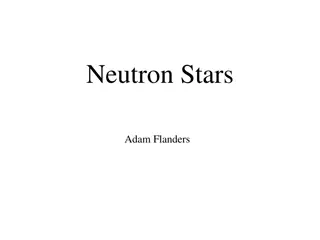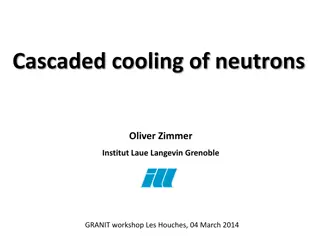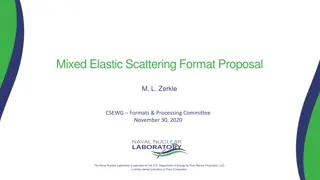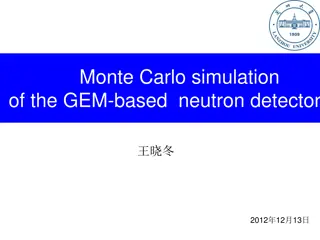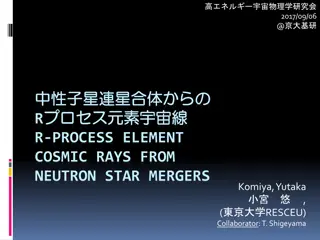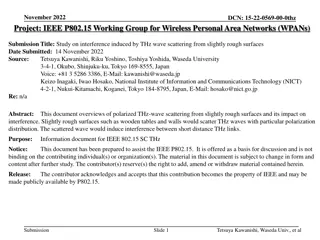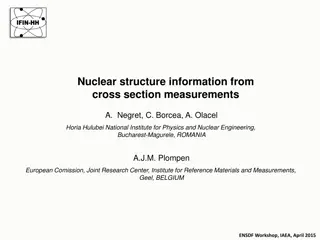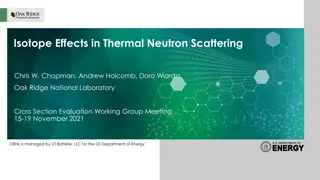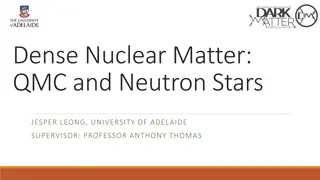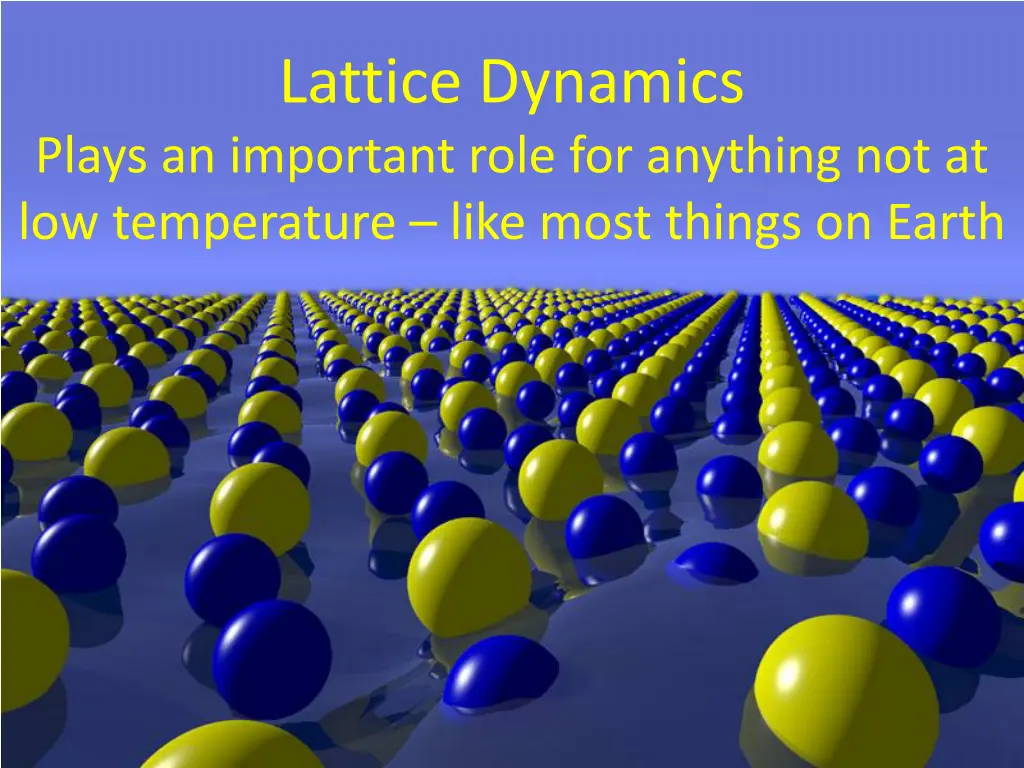
Understanding the Role of Lattice Dynamics in Crystal Structures
Explore the significance of lattice dynamics in systems not at low temperatures, analyze dispersion curves, and learn about vibrational modes in monatomic lattices. Discover how to derive equations of motion in the harmonic approximation for infinite linear chains.
Download Presentation

Please find below an Image/Link to download the presentation.
The content on the website is provided AS IS for your information and personal use only. It may not be sold, licensed, or shared on other websites without obtaining consent from the author. If you encounter any issues during the download, it is possible that the publisher has removed the file from their server.
You are allowed to download the files provided on this website for personal or commercial use, subject to the condition that they are used lawfully. All files are the property of their respective owners.
The content on the website is provided AS IS for your information and personal use only. It may not be sold, licensed, or shared on other websites without obtaining consent from the author.
E N D
Presentation Transcript
Lattice Dynamics Plays an important role for anything not at low temperature like most things on Earth
Objectives By the end of today you should be able to: Apply the equations of motion to 1D systems with one or more atoms in the basis Expand 1D model into 2 and 3 dimensions Analyze the dispersion curves for real crystals
> interatomic spacing continuum approach fails
> interatomic spacing continuum approach fails phonons vibrational modes quantized
> interatomic spacing continuum approach fails phonons vibrational modes quantized Phonons are responsible for the majority of the thermal capacity of solids (a later lecture). Also important for electrical conductivity
Vibrational Modes of a Monatomic Lattice Linear chain: Remember: two coupled harmonic oscillators Anti-symmetric mode Symmetric mode Superposition of normal modes When you have two masses, you have two modes. But, we have lots of atoms in our crystal! Start with 1D
generalization Infinite linear chain How to derive the equation of motion in the harmonic approximation ? n n-2 n-1 n+1 n+2 a C un un+1 un-2 un-1 un+2 un un+1 un-2 un-1 un+2 fixed
generalization Infinite linear chain How to derive the equation of motion in the harmonic approximation ? n n-2 n-1 n+1 n+2 a C un un+1 un-2 un-1 un+2 un un+1 un-2 un-1 un+2 fixed
generalization Infinite linear chain How to derive the equation of motion in the harmonic approximation ? n n-2 n-1 n+1 n+2 a C un un+1 un-2 un-1 un+2 ( ) = l F C u u 1 n n n un un+1 un-2 un-1 un+2 fixed
generalization Infinite linear chain How to derive the equation of motion in the harmonic approximation ? n n-2 n-1 n+1 n+2 a C un un+1 un-2 un-1 un+2 ( ) = r F C u u + 1 n n n ( ) = l F C u u 1 n n n un un+1 un-2 un-1 un+2 fixed
Total force driving atom n back to equilibrium ( ) = + ( ) ( ) 2 C u u u = F C u u C u n u + 1 1 n n n n n + 1 1 n n n n
Total force driving atom n back to equilibrium ( ) = + ( ) ( ) 2 C u u u = F C u u C u n u + 1 1 n n n n n + 1 1 n n n n = C m u F equation of motion n n ( ) = + 2 u u u u + 1 1 n n n n m
Total force driving atom n back to equilibrium ( ) = + ( ) ( ) 2 C u u u = F C u u C u n u + 1 1 n n n n n + 1 1 n n n n = C m u F equation of motion n n ( ) = + 2 u u u u + 1 1 n n n n m ( ie kx ) t = Old solution for continuous wave equation was . Use similar? u A
Total force driving atom n back to equilibrium ( ) = + ( ) ( ) 2 C u u u = F C u u C u n u + 1 1 n n n n n + 1 1 n n n n = C m u F equation of motion n n ( ) = + 2 u u u u + 1 1 n n n n m ( ie kx ) t = Old solution for continuous wave equation was . Use similar? u A ? ( i kna ) t Let us try! = u A e approach for linear chain n
Total force driving atom n back to equilibrium ( ) = + ( ) ( ) 2 C u u u = F C u u C u n u + 1 1 n n n n n + 1 1 n n n n = C m u F equation of motion n n ( ) = + 2 u u u u + 1 1 n n n n m ( ie kx ) t = Old solution for continuous wave equation was . Use similar? u A ? ( i kna ) t Let us try! = u A e approach for linear chain n ( i kna ) t 2 = u A e n
Total force driving atom n back to equilibrium ( ) = + ( ) ( ) 2 C u u u = F C u u C u n u + 1 1 n n n n n + 1 1 n n n n = C m u F equation of motion n n ( ) = + 2 u u u u + 1 1 n n n n m ( ie kx ) t = Old solution for continuous wave equation was . Use similar? u A ? ( i kna ) t Let us try! = u A e approach for linear chain n ( i kna ) t ( i kna ) t ika e 2 = += 1 u A e u A e , n n
Total force driving atom n back to equilibrium ( ) = + ( ) ( ) 2 C u u u = F C u u C u n u + 1 1 n n n n n + 1 1 n n n n = C m u F equation of motion n n ( ) = + 2 u u u u + 1 1 n n n n m ( ie kx ) t = Old solution for continuous wave equation was . Use similar? u A ? ( i kna ) t Let us try! = u A e approach for linear chain n ( i kna ) t ( i kna ) t ika e 2 ika ( i kna ) t = += 1 u A e u A e = 1 u A e e , , n n n
Total force driving atom n back to equilibrium ( ) = + ( ) ( ) 2 C u u u = F C u u C u n u + 1 1 n n n n n + 1 1 n n n n = C m u F equation of motion n n ( ) = + 2 u u u u + 1 1 n n n n m ( ie kx ) t = Old solution for continuous wave equation was . Use similar? u A ? ( i kna ) t Let us try! = u A e approach for linear chain n ( i kna ) t ( i kna ) t ika e 2 ika ( i kna ) t = += 1 u A e u A e = 1 u A e e , , n n n ( ) 2 C ika = + 2 ika e e m
Total force driving atom n back to equilibrium ( ) = + ( ) ( ) 2 C u u u = F C u u C u n u + 1 1 n n n n n + 1 1 n n n n = C m u F equation of motion n n ( ) = + 2 u u u u + 1 1 n n n n m ( ie kx ) t = Old solution for continuous wave equation was . Use similar? u A ? ( i kna ) t Let us try! = u A e approach for linear chain n ( i kna ) t ( i kna ) t ika e 2 ika ( i kna ) t = += 1 u A e u A e = 1 u A e e , , n n n ( ) 2 C C ( ) ika = + 2 ika e e = 2 2 1 cos ka m m
Total force driving atom n back to equilibrium ( ) = + ( ) ( ) 2 C u u u = F C u u C u n u + 1 1 n n n n n + 1 1 n n n n = C m u F equation of motion n n ( ) = + 2 u u u u + 1 1 n n n n m ( ie kx ) t = Old solution for continuous wave equation was . Use similar? u A ? ( i kna ) t Let us try! = u A e approach for linear chain n ( i kna ) t ( i kna ) t ika e 2 ika ( i kna ) t = += 1 u A e u A e = 1 u A e e , , n n n ( ) 2 C C ( ) C ika = + 2 ika e e = 2 2 1 cos ka = 2 sin( ) 2 / ka m m m
C = 2 sin( ) 2 / ka m C 2 m Note: here pictures of transversal waves although calculation for the longitudinal case k 2 Continuum limit of acoustic waves: = k 0 C = = C v a = + sin ka / ka / ... 2 2 = a k k m m
Technically, only have longitudinal modes in 1D (but transverse easier to see what s happening) x = na un un (a) Chain of atoms in the absence of vibrations.
Technically, only have longitudinal modes in 1D (but transverse easier to see what s happening) x = na un un (a) Chain of atoms in the absence of vibrations. (c) A transverse (T) wave traveling along x. Atomic displacements (un) are perpendicular to the x axis. (b) and (c) are snapshots at one instant.
Technically, only have longitudinal modes in 1D (but transverse easier to see what s happening) x = na un un (a) Chain of atoms in the absence of vibrations. (b) Coupled atomic vibrations generate a traveling longitudinal (L) wave along x. Atomic displacements (un) are parallel to x. (c) A transverse (T) wave traveling along x. Atomic displacements (un) are perpendicular to the x axis. (b) and (c) are snapshots at one instant.
Slope at boundary? Results in same motion of the atoms Arbitrary origin k 2 = + k k h , here h=1 What was the slope equal to for low k? a 1-dim. reciprocal lattice vector Same as before! 2 + (( i e k h ) na ) t ) t ) k ( k ( ie na k ( ie na ) t k ( ie na ) t ie h n 2 k ( ie na ) t = = a u A A = = A = A n A 2 k ( = ) k ( ) = + k k h ie h n 2 = 1 a Region k is called Means we only have to consider a small range of k values rather than all possible wavelengths! a a first Brillouin zone
What is going on at the edge of the Brillouin zone? ~ A A~ y~ 1 A~ ~ y y~ y~ = ( ) ie kx t 1 + ( ie y~ e kx ) t e = 2 A~ + ( i kx ) t ( i kx ) t = + = + e s 2 A~ ikx + ikx i t i t = 2 e cos t = e e = = Re( ) 2 s y cos cos y A kx t s Equivalent to a Bragg reflection of x-rays. When the Bragg condition is satisfied, the wave does not travel but reflects back and forth forming a standing wave.
What if we had more than nearest neighbor interactions? How to derive the equation of motion in the harmonic approximation ? n n-2 n-1 n+1 n+2 a C un un+1 un-2 un-1 un+2 ( ) = r F C u u + 1 n n n ( ) = l F C u u 1 n n n un un+1 un-2 un-1 un+2 fixed


